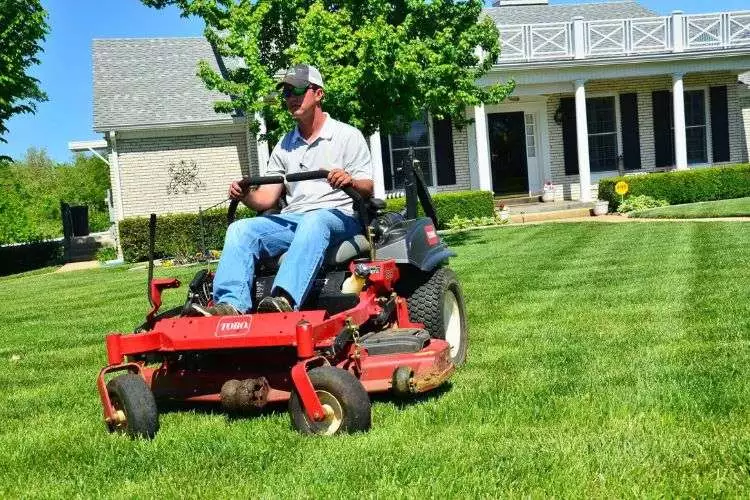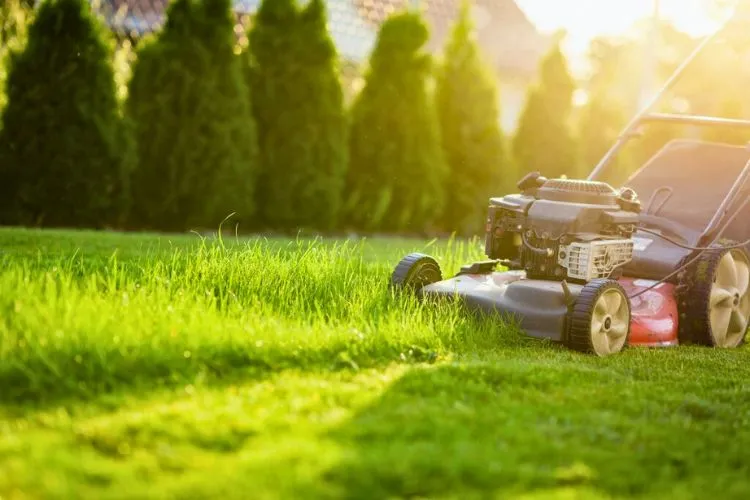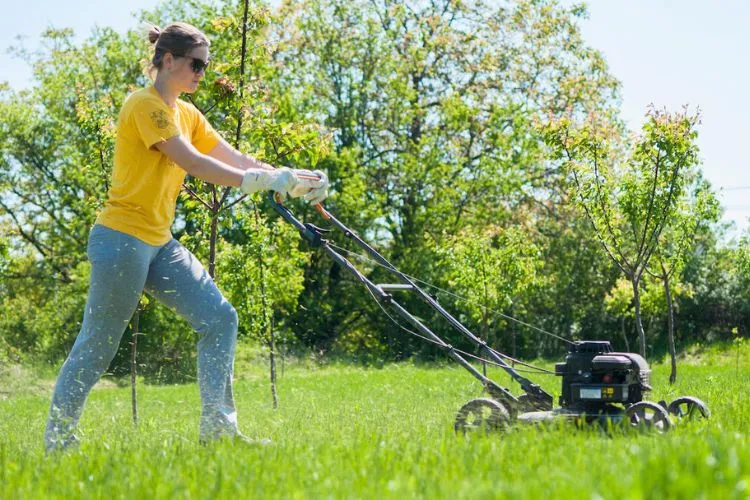When striving for the perfect lawn, homeowners often encounter the conundrum of managing and protecting freshly seeded areas.
Lawn netting presents itself as a guardian, fostering seed growth and reducing erosion. Yet, as grass matures, the question arises: can you mow over lawn netting without causing harm to your mower, or sabotaging the very turf you’ve endeavored to cultivate?
In this article, we delve into the mechanics and best practices of mowing when lawn netting is part of your garden’s tapestry, ensuring your green sanctuary continues to flourish without falling foul of your garden machinery.

We understand how important a well-manicured, healthy lawn is to you, and we’re here to help ensure your lawn care practices are as effective as possible. Let’s dive in!
Table of Contents
can you mow over lawn netting? A Clear Answer
No, mowing over lawn netting is not recommended as it can entangle in the lawnmower blades, causing damage. It is crucial to remove or lift the netting before mowing the lawn to ensure safety and prevent any potential hazards or complications.
It’s worth mentioning here that the lawn netting serves a specific purpose, such as preventing erosion or protecting newly seeded areas.
Pros and Cons of Mowing Over Lawn Netting
As we delve deeper into lawn netting, we encounter the central question – what are the potential benefits and drawbacks of mowing over this protective layer?
Life is a game of balance, and the same applies to our gardening practices. To help you make an informed decision, let’s dissect the pros and cons of this practice in greater detail.

Advantages of mowing over lawn netting
Mowing over lawn netting might seem daunting, but it has several perks. From convenience to aiding weed control and boosting soil erosion prevention, the benefits are worth exploring.
Time-saving and convenience
In my three-decade experience, one aspect of lawn care that garden enthusiasts appreciate is convenience. And mowing over lawn netting fits the bill. The process negates the need to remove and reinstall the netting each time your lawn needs trimming.
It’s not just a matter of saving time – it’s about avoiding the painstaking process of ensuring each corner is well-secured, every inch of your lawn is covered, and the netting is taut and well-positioned.
Over the years, I’ve found that leaving the netting in place while mowing saves gardeners countless hours, which can be used to tackle other aspects of garden maintenance.
Reduction in weed growth
The battle against weeds is a constant in the world of gardening. Mowing over lawn netting offers extra defense against these persistent invaders.
As you mow, the cut grass falls onto the net and forms a natural layer of mulch. This layer not only helps retain soil moisture but also blocks sunlight from reaching potential weed seeds, halting their growth before they even get a chance to start.
This phenomenon, witnessed over my long gardening journey, is a natural weed control method, making your lawn care routine more efficient.
Prevention of soil erosion
Lawn netting shines in its role as a protector against soil erosion. When mowing over the net, the protective layer remains undisturbed, holding the soil firmly in place.
This is especially vital on slopes and uneven terrains, where the soil is more prone to wash away during heavy rains or winds.
By leaving the netting intact, you reinforce the groundwork and promote a healthier, more resilient lawn.
Disadvantages of mowing over lawn netting
Like any practice, mowing over lawn netting isn’t without its challenges. Understanding these potential pitfalls is crucial in making the best decisions for your lawn care.
Potential damage to the netting
One risk of mowing over lawn netting is possibly causing damage to the net.
Lawnmower blades can rip or tear the netting, particularly if set too low. I’ve seen instances where a single mowing session has rendered the netting ineffective, leading to potential damage to the grass underneath or making the lawn susceptible to pests.
It’s a significant concern to remember before mowing over lawn netting.
Risks of tangling or damaging the lawn mower blades
From years of observations, I can attest that lawn netting can become a foe to your lawnmower. The netting, especially string-based, may get caught up in the mower’s blades.
This entanglement could result in potential damage to the machinery, leading to costly repairs or replacements. Even worse, a jammed mower could become a safety hazard if not promptly and properly addressed.
Ineffectiveness in certain situations, such as uneven terrain or large debris on the lawn
In some scenarios, mowing over lawn netting may not be practical. If your lawn is uneven or there’s considerable debris, mowing over the netting could be challenging, if not impossible.
Large sticks, stones, or other residue can get caught in the net, making mowing a nightmare. Similarly, uneven terrain increases the risk of not only damaging the net but also potentially damaging the mower.
Balancing these pros and cons will help guide your decision about whether mowing over lawn netting is the right approach for your garden.
Like every aspect of lawn care, it’s about tailoring the practice to your unique circumstances, weighing convenience against practicality, and prioritizing the health of your lawn.
Factors to Consider
Making the call to mow over lawn netting or not is a decision that shouldn’t be taken lightly. Several factors come into play when making this judgement.
You’ll want to assess the quality and durability of the lawn netting, the type of lawnmower at your disposal, the height and thickness of the grass, and the overall condition of the lawn. Let’s dig into each of these aspects.

Quality and durability of the lawn netting
Your lawn netting’s quality and durability are paramount when mowing over it. The stronger and more durable the netting, the better it can withstand the rigours of mowing.
High-quality netting, typically made of strong materials like polypropylene, can often withstand the pressure of a mower without tearing or getting damaged.
If your netting is thin, weak, or showing signs of wear and tear, mowing over it might not be the best idea.
Type of lawnmower being used
The kind of lawnmower you’re using also factors into the equation. Some mowers are more aggressive in their operation, while others are gentler on the terrain.
For instance, reel mowers are often less damaging to lawn netting than rotary mowers because they cut in a scissor-like action rather than tearing or ripping the grass.
The mower’s height setting also comes into play here; setting it higher can help avoid contact with the netting, reducing the risk of damage.
Height and thickness of the grass
The height and thickness of your grass also play a role.
If your grass is thick and tall, it can provide a layer of protection for the netting when you mow, reducing the likelihood of the mower coming into direct contact with the net.
However, if the grass is short and sparse, the netting might be more exposed, increasing the risk of damage during mowing.
Overall condition and levelness of the lawn
Finally, consider the overall condition and level of your lawn. A flat, even lawn, is less likely to cause problems when mowing over lawn netting.
On the contrary, a lawn with dips, bumps, or slopes can increase the risk of the mower blades coming into contact with the netting.
The lawn’s condition matters, too; for instance, a lawn riddled with stones, sticks, or other debris can pose a risk to both the netting and the mower.
Considering these factors can help you make an informed decision about whether or not to mow your lawn netting.
It’s all about making choices that promote the health and well-being of your lawn while ensuring the convenience and sustainability of your gardening practices.
Frequently Asked Questions (fAQs)
Can you use any type of lawnmower with lawn netting?
Not all types of lawnmowers are suitable for mowing over lawn netting. Those with adjustable cutting height and sharp, well-maintained blades are best.
Will mowing over lawn netting affect the quality of the grass?
If mowing over lawn netting is done carefully and correctly, it should not affect the quality of the grass.
How often should the lawn netting be replaced?
The lifespan of lawn netting varies based on quality, but generally, it should be replaced once signs of wear or damage appear.
Can lawn netting be used in all types of weather conditions?
Lawn netting can be used in various weather conditions, but it might deteriorate faster in extreme conditions such as intense heat or heavy snow.
When should I remove lawn netting?
Lawn netting should be removed when the grass underneath has sufficiently matured and can withstand external pressures without the net’s support.
Can I mow over lawn netting with a riding lawn mower?
Yes, you can mow over lawn netting with a riding lawn mower, provided it is done cautiously to avoid damage to both the netting and the mower.
Conclusion:
In this comprehensive guide, we’ve explored the world of lawn netting, its purpose, types, and construction.
We’ve weighed the pros and cons of mowing over lawn netting, examined various factors to consider, provided guidelines, and suggested alternatives.
Can you mow over lawn netting? The answer is no, you shouldn’t. But if you have to do it, the you should only do it with care.
The decision should hinge on your specific situation, the type of netting and lawnmower, and the condition of your lawn. Remember our pro tips and consult your netting manufacturer for any specific guidelines.
We hope that this guide has been helpful. You can read about similar topics here on our website. Check back again soon for more.
Because, in the end, our goal is to ensure your green spaces flourish, becoming a source of joy and pride. Happy gardening!


